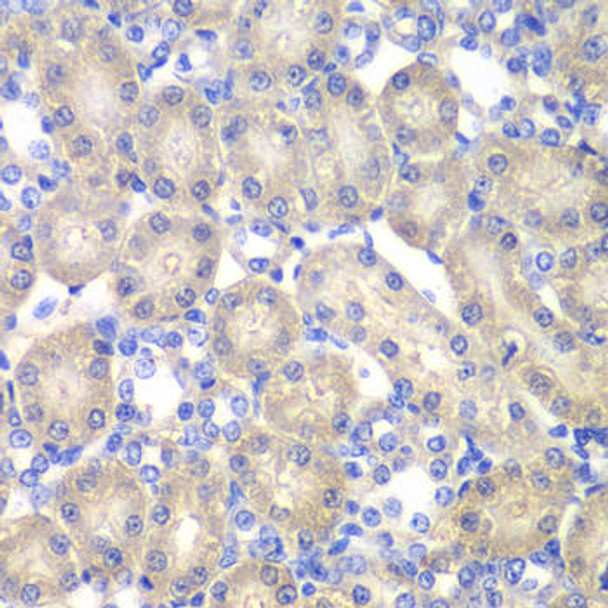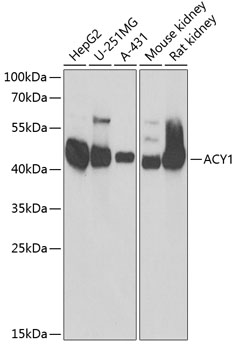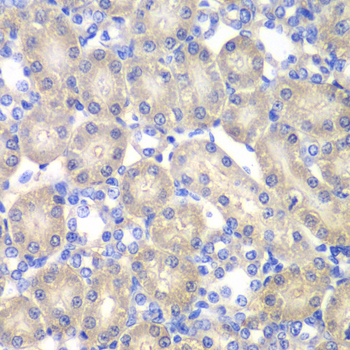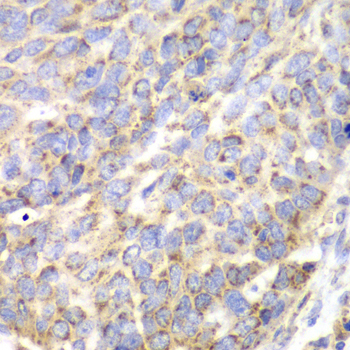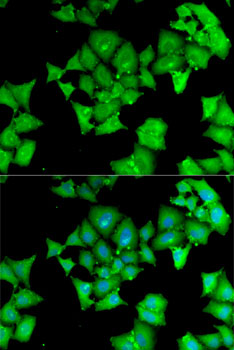Anti-ACY1 Antibody (CAB13458)
- SKU:
- CAB13458
- Product type:
- Antibody
- Reactivity:
- Human
- Reactivity:
- Mouse
- Reactivity:
- Rat
- Host Species:
- Rabbit
- Isotype:
- IgG
- Antibody Type:
- Polyclonal Antibody
- Research Area:
- Cell Biology
Frequently bought together:
Description
| 抗体名: | Anti-ACY1 Antibody |
| 抗体コード: | CAB13458 |
| 抗体サイズ: | 20uL, 50uL, 100uL |
| 申し込み: | WB IHC IF |
| 反応性: | Human, Mouse, Rat |
| 宿主種: | Rabbit |
| 免疫原: | Recombinant fusion protein containing a sequence corresponding to amino acids 1-408 of human ACY1 (NP_001185824.1). |
| 申し込み: | WB IHC IF |
| 推奨希釈: | WB 1:500 - 1:2000 IHC 1:50 - 1:200 IF 1:50 - 1:200 |
| 反応性: | Human, Mouse, Rat |
| ポジティブサンプル: | HepG2, U-251MG, A-431, Mouse kidney, Rat kidney |
| 免疫原: | Recombinant fusion protein containing a sequence corresponding to amino acids 1-408 of human ACY1 (NP_001185824.1). |
| 精製方法: | Affinity purification |
| ストレージバッファ: | Store at -20'C. Avoid freeze / thaw cycles. Buffer: PBS with 0.02% sodium azide, 50% glycerol, pH7.3. |
| アイソタイプ: | IgG |
| 順序: | MTSK GPEE EHPS VTLF RQYL RIRT VQPK PDYG AAVA FFEE TARQ LGLG CQKV EVAP GYVV TVLT WPGT NPTL SSIL LNSH TDVV PVFK EHWS HDPF EAFK DSEG YIYA RGAQ DMKC VSIQ YLEA VRRL KVEG HRFP RTIH MTFV PDEE VGGH QGME LFVQ RPEF HALR AGFA LDEG IANP TDAF TVFY SERS PWWV RVTS TGRP GHAS RFME DTAA EKLH KVVN SILA FREK EWQR LQSN PHLK EGSV TSVN LTKL EGGV AYNV IPAT MSAS FDFR VAPD VDFK AFEE QLQS WCQA AGEG VTLE FAQK WMHP QVTP TDDS NPWW AAFS RVCK DMNL TLEP EIMP AATD NRYI RAVG VPAL GFSP MNRT PVLL HDHD ERLH EAVF LRGV DIYT RLLP ALAS VPAL PSDS |
| 遺伝子ID: | 95 |
| Uniprot: | Q03154 |
| セルラーロケーション: | Cytoplasm |
| 計算された分子量: | 37kDa/38kDa/42kDa/45kDa |
| 観察された分子量: | 46kDa |
| 同義語: | ACY1, ACY-1, ACY1D, HEL-S-5 |
| バックグラウンド: | This gene encodes a cytosolic, homodimeric, zinc-binding enzyme that catalyzes the hydrolysis of acylated L-amino acids to L-amino acids and an acyl group, and has been postulated to function in the catabolism and salvage of acylated amino acids. This gene is located on chromosome 3p21.1, a region reduced to homozygosity in small-cell lung cancer (SCLC), and its expression has been reported to be reduced or undetectable in SCLC cell lines and tumors. The amino acid sequence of human aminoacylase-1 is highly homologous to the porcine counterpart, and this enzyme is the first member of a new family of zinc-binding enzymes. Mutations in this gene cause aminoacylase-1 deficiency, a metabolic disorder characterized by central nervous system defects and increased urinary excretion of N-acetylated amino acids. Alternative splicing of this gene results in multiple transcript variants. Read-through transcription also exists between this gene and the upstream ABHD14A (abhydrolase domain containing 14A) gene, as represented in GeneID:100526760. A related pseudogene has been identified on chromosome 18. |
| UniProt Protein Function: | ACY1: Involved in the hydrolysis of N-acylated or N-acetylated amino acids (except L-aspartate). Defects in ACY1 are the cause of aminoacylase-1 deficiency (ACY1D). ACY1D results in a metabolic disorder manifesting with encephalopathy, unspecific psychomotor delay, psychomotor delay with atrophy of the vermis and syringomyelia, marked muscular hypotonia or normal clinical features. Epileptic seizures are a frequent feature. All affected individuals exhibit markedly increased urinary excretion of several N-acetylated amino acids. Belongs to the peptidase M20A family. |
| UniProt Protein Details: | Protein type:Hydrolase; EC 3.5.1.14; Amino Acid Metabolism - arginine and proline Chromosomal Location of Human Ortholog: 3p21.1 Cellular Component: cytosol Molecular Function:metallopeptidase activity; metal ion binding; aminoacylase activity Biological Process: amino acid metabolic process; xenobiotic metabolic process; proteolysis Disease: Aminoacylase 1 Deficiency |
| NCBI Summary: | This gene encodes a cytosolic, homodimeric, zinc-binding enzyme that catalyzes the hydrolysis of acylated L-amino acids to L-amino acids and an acyl group, and has been postulated to function in the catabolism and salvage of acylated amino acids. This gene is located on chromosome 3p21.1, a region reduced to homozygosity in small-cell lung cancer (SCLC), and its expression has been reported to be reduced or undetectable in SCLC cell lines and tumors. The amino acid sequence of human aminoacylase-1 is highly homologous to the porcine counterpart, and this enzyme is the first member of a new family of zinc-binding enzymes. Mutations in this gene cause aminoacylase-1 deficiency, a metabolic disorder characterized by central nervous system defects and increased urinary excretion of N-acetylated amino acids. Alternative splicing of this gene results in multiple transcript variants. Read-through transcription also exists between this gene and the upstream ABHD14A (abhydrolase domain containing 14A) gene, as represented in GeneID:100526760. A related pseudogene has been identified on chromosome 18. [provided by RefSeq, Nov 2010] |
| UniProt Code: | Q03154 |
| NCBI GenInfo Identifier: | 461466 |
| NCBI Gene ID: | 95 |
| NCBI Accession: | Q03154.1 |
| UniProt Secondary Accession: | Q03154,C9J6I6, C9J9D8, C9JWD4, |
| UniProt Related Accession: | Q03154 |
| Molecular Weight: | 408 |
| NCBI Full Name: | Aminoacylase-1 |
| NCBI Synonym Full Names: | aminoacylase 1 |
| NCBI Official Symbol: | ACY1 |
| NCBI Official Synonym Symbols: | ACY-1; ACY1D; HEL-S-5 |
| NCBI Protein Information: | aminoacylase-1; epididymis secretory protein Li 5; N-acyl-L-amino-acid amidohydrolase |
| UniProt Protein Name: | Aminoacylase-1 |
| UniProt Synonym Protein Names: | N-acyl-L-amino-acid amidohydrolase |
| Protein Family: | Aminoacylase |
| UniProt Gene Name: | ACY1 |
| UniProt Entry Name: | ACY1_HUMAN |

